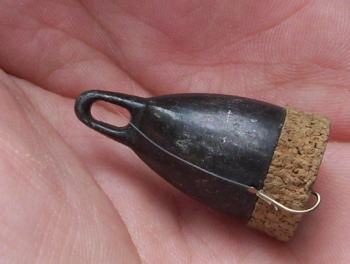A plummet is usually made of a heavy material, such as lead, as it needs to be fairly weighty. Normally, the hook passes through an eye at the top of the plummet and is embedded by the angler in the cork bottom. There are other versions that clip on.
 It is used by the float angler to obtain a true depth reading of the swim in front of him; or to plot variations in the lake bed which may provide clues to fish holding features. Initially, the float is slid onto the mainline and locked in place using shot, rubbers, stops or any other method to anchor the float at an estimated depth.
It is used by the float angler to obtain a true depth reading of the swim in front of him; or to plot variations in the lake bed which may provide clues to fish holding features. Initially, the float is slid onto the mainline and locked in place using shot, rubbers, stops or any other method to anchor the float at an estimated depth.
When the weighted rig is cast to the required spot, if the rig is set too shallow, then the float will not be visible at the surface because the weight of the plummet will ensure the float stays below; if the float surfaces and lays flat, then the rig is set too deep. Ideally, to find the exact depth, the float should sit with ¼ inch seen by the angler. This means that the bait just trips the bottom to entice the fish, and also, perhaps more importantly, the fisherman knows the depth of water in the swim. This will be important when weather conditions, wind, target species and bait to be used are considered.
Many float anglers use ‘hooks to nylon’ to ensure a delicate presentation; it is important to remember that if the hook length is changed, then it may be necessary to re-plumb the swim as hook lengths may be vary amongst manufacturers. Once the rig is set properly, variations to find the depth at which fish are feeding becomes easy, it may not be on the bottom, but in mid-water, so a change may be useful. Try to mark the original depth though to save plumbing up again if the fish begin to feed at another level. Setting the correct depth to fish at is one of the fundamental tasks before the float angler; getting it right may be the difference between a fantastic day and a blank, but practice makes perfect, so get out there and try it for yourself!
Clint Walker , June 2009

Float locked with rubber stops




















